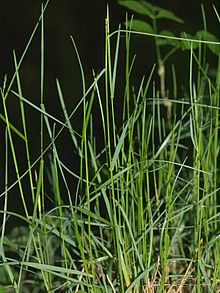
Poa pratensis, commonly known as Kentucky bluegrass, smooth meadow-grass, or common meadow-grass, is a perennial species of grass native to practically all of Europe, North Asia and the mountains of Algeria and Morocco. It is a common and incredibly popular lawn grass in North America with the species being spread over all of the cool, humid parts of the United States, despite the fact that it is not native to North America. The Spanish Empire brought the seeds of Kentucky bluegrass to the New World in mixtures with other grasses. In its native range, Poa pratensis forms a valuable pasture plant, characteristic of well-drained, fertile soil. It is also used for making lawns in parks and gardens and has established itself as a common invasive weed across cool moist temperate climates like the Pacific Northwest and the Northeastern United States. When found on native grasslands in Canada, for example, it is considered an unwelcome exotic plant, and is indicative of a disturbed and degraded landscape.

Poa is a genus of about 570 species of grasses, native to the temperate regions of both hemispheres. Common names include meadow-grass, bluegrass, tussock, and speargrass. Poa is Greek for 'fodder'. Poa are members of the subfamily Pooideae of the family Poaceae.

Poa annua, or annual meadow grass, is a widespread low-growing turfgrass in temperate climates. Notwithstanding the reference to annual plant in its name, perennial bio-types do exist. This grass originated as a hybrid between Poa supina and Poa infirma. Major chromosomal rearrangements after polyploidy have contributed to variation in genome size in Poa annua.
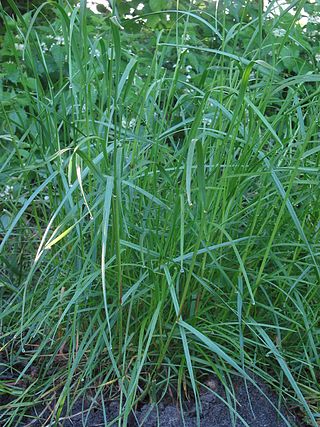
Lolium perenne, common name perennial ryegrass, English ryegrass, winter ryegrass, or ray grass, is a grass from the family Poaceae. It is native to Europe, Asia and northern Africa, but is widely cultivated and naturalised around the world.

Poa trivialis, is a perennial plant regarded in the US as an ornamental plant. It is part of the grass family.

Poa compressa, the Canada bluegrass or flattened meadow-grass, is a perennial flattened meadow grass, similar to common meadow-grass, Poa pratensis. It is native to Europe but it can be found nearly worldwide as an introduced species. It grows in old wall tops, pavement cracks, dry stony grassland, and many types of wild habitat. It has a flattened stem, 23–30 cm tall, a close one sided panicle of grey green, with purple florets.
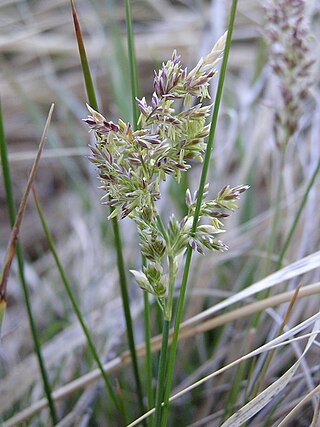
Poa atropurpurea is a rare species of grass known by the common name San Bernardino bluegrass. It is endemic to southern California, where it is known from two regions, the San Bernardino Mountains near Big Bear and the Laguna Mountains of San Diego County.

Poa bigelovii is a species of grass known by the common name Bigelow's bluegrass. It is native to the southwestern United States and northwestern Mexico, where it grows in shady spots in desert and plateau habitat.
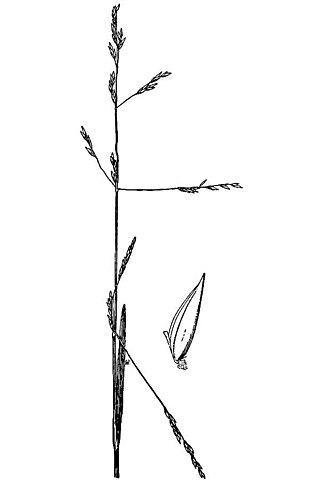
Poa bolanderi is a species of grass known by the common name Bolander's bluegrass. It is native to western North America from British Columbia to Utah to California, where it is a resident of mountain habitat, particularly pine and fir forests. It is an annual grass growing in clumps up to 60 centimeters tall. The inflorescence occupies the top 10 to 15 centimeters of the stem. It is narrow in flower, with branches appressed, growing parallel to the stem. As the fruit develops the branches spread out, becoming perpendicular to the stem, nodding, or drooping. The branches have few, sparse spikelets.
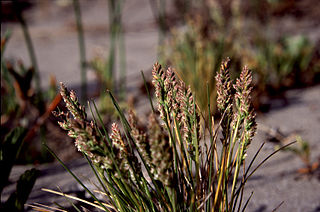
Poa confinis is a species of grass known by the common names coastline bluegrass and beach bluegrass. It is native to the coastline of western North America from British Columbia to northern California, where it grows on beaches, dunes, and other coastal habitat.
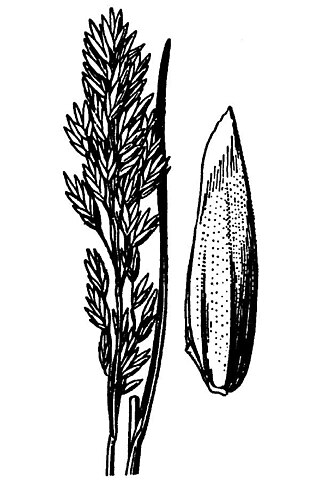
Poa cusickii is a species of grass known by the common name Cusick's bluegrass. It is native to western North America from Yukon to Colorado to eastern California, where it grows in many types of habitat, including high mountain meadows and slopes, sagebrush scrub, and forests.

Poa douglasii is a species of grass known by the common names Douglas' bluegrass and sand dune bluegrass. It is endemic to the coastline of California, where it grows in shifting sand dunes. It can be found mostly along the Central Coast and Channel Islands, and occasionally on the North Coast north of Mendocino. It is a perennial grass growing small, dense clumps up to about 30 centimeters in maximum height. It grows from a network of long rhizomes and stolons that anchor the grass to its loose sandy substrate; this network may be up to one meter long. The inflorescence is a dense, oval-shaped series of overlapping spikelets. The grass is dioecious, with male and female individuals producing different types of flowers in their inflorescences. This species, like many sand-dune endemic plants, is threatened by invasive species.

Poa kelloggii is a species of grass known by the common name Kellogg's bluegrass. It is endemic to the North and Central Coasts of California, where it grows in coastal forests, including redwood forests. It is a perennial grass producing single stems or loose clumps of several stems up to 85 centimeters tall. The inflorescence is a series of branches along the stem which spread out and then droop as the fruit matures. The flattened spikelets occur at the tips of the thin branches.

Poa leptocoma is a species of grass known by the common names marsh bluegrass and western bog bluegrass.

Poa macrantha is a species of grass known by the common names seashore bluegrass and large-flowered sand dune bluegrass. It is native to the west coast of North America from Alaska to northern California, where it grows in sand dunes and other beach habitat.
Poa diaboli is a rare species of grass known by the common name Diablo Canyon bluegrass. It is endemic to San Luis Obispo County, California, where it is known from about five occurrences in the San Luis Mountains near the coast. The type specimen was collected in Montaña de Oro State Park and the grass was described as a new species in 2003. The grass occurs on rugged mountaintops and north-facing slopes in thin soils covering shale rock within a few kilometers of the coastline. Its habitat includes chaparral, oak woodland, coastal sage scrub, and Bishop pine forest.
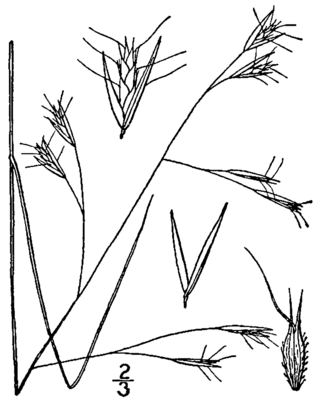
Danthonia compressa is a species of grass known by the common names mountain oatgrass, flattened oatgrass, and slender oatgrass.

Poa arida is a species of grass known by the common names plains bluegrass and prairie speargrass. It is native to North America, where it occurs throughout western and central Canada and the central United States. It is most common east of the Continental Divide; specimens west are often misidentifications.

Poa paludigena is a species of grass known by the common names bog bluegrass, marsh bluegrass, slender marsh bluegrass, and Patterson's bluegrass. It is native to the northeastern United States.

Poa cuspidata, commonly called early bluegrass, is a species of flowering plant in the grass family (Poaceae). It is native to the eastern United States, where its range extends from Appalachian regions into the Coastal Plain, where it is less common. In the Appalachian mountains, it is a common species found in forest openings.
